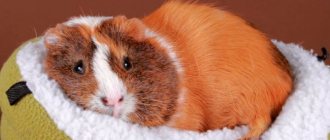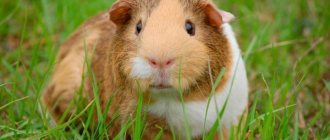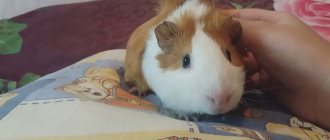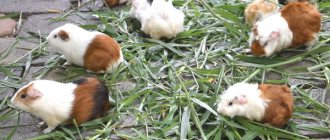- home
- Guinea pig
- Guinea pig health
02/18/2019 The guinea pig’s body needs a certain amount of fluid every day. The animal receives it both from the drinking bowl and from succulent food. The volume of clean water consumed by a pet serves as an indicator of its health status - normal or deteriorated. A sick animal loses not only its appetite, but also its desire to drink. But there are also frequent cases when a decrease in a rodent’s fluid intake is not associated with the development of the disease and the reason lies elsewhere. To understand why a guinea pig does not drink water, you should observe your pet for several days.
Guinea pig doesn't drink water
Like any other pet, a guinea pig needs water.
Absence can have a significant impact not only on health and activity, but also on vitality. Thirst can be influenced by: the amount of dry and succulent food, age, room temperature, activity, and finally, sweets and other not recommended foods. By getting enough moisture from greens and vegetables, water may be virtually unnecessary. In the wild it is used quite rarely. There can be many reasons why a pet refuses to drink; the main ones will be discussed below. A guinea pig does not drink water for the following reasons:
- The diet includes a sufficient amount of juicy vegetables, herbs and greens;
- The pig is experiencing stress, which may be associated with moving to a new cage. Very often, pets are plunged into this state after purchasing them.
- Not taught to drink from a drinking bowl. Perhaps previously only a bowl was available, and that is what the pet will be looking for.
- The drinking bowl is hung outside the reach, for example, a little high. Ideal placement at head level so you don't have to stretch to get a drink.
- Technical malfunction of the drinker. Check whether the ball in the tube allows water to pass through; perhaps the channel is clogged;
- The fluid is rotten or very old. To be replaced with a fresh one every 2-3 days (ideally daily).
If your pig used to drink water, but now has stopped, it may be that the diet has now included everything it needs. There is enough moisture and there is no need to resort to searching for additional moisture. Another option is that there is a desire, but there is no opportunity. Twist the ball with your finger; if a drop does not come out, then you need to clean it.
How long can a hamster live without food and water?
The hamster is a favorite pet of many adults and children. A cute little bundle can bring a lot of happiness to your home. It does not require complex care and a lot of time.
There are situations in life when a family needs to leave home. For example, go on vacation to the seashore. It is not possible to take a small pet long distance. There are several questions that owners ask themselves. How long can a hamster live without food? How to prepare housing for departure?
It is better not to experiment on animals. No one has tested it, and it is impossible to answer for sure, but several theoretical analyzes have been carried out.
Ideally, rodents need to change their food and water daily. But many owners throw out food and add new food once every few days. This is not scary and will not affect the hamster’s condition in any way. Therefore, you can leave the hamster for 3 days. If you need to leave for a whole week, then you shouldn’t risk his life and it’s better to give your pet and house to friends or relatives.
If this option is not suitable, you need to carefully prepare for a long departure. The rodent will not be bored if there are toys in the cage. And he cannot live without food and liquid.
There are certain rules for preparing your home:
- Be sure to do a complete cleaning and throw out everything unnecessary from the cage, pour a thick layer of new filler. Hamsters have a special place where they hide food. These reserves should not be touched; this will lead to great stress. Before departure you must:
- Pour food into the feeder.
- Hide enough food in different places. This way the animal will definitely not remain hungry. When the food in the feeder runs out, he will look for it in the cage.
- Only dry food should be left. Chicken, fruits and vegetables will quickly spoil without refrigeration.
- You can only leave a small piece of raw carrots. They do not spoil for a long time and in the first two days the rodent will definitely eat it.
- Hamsters cannot starve, so it is better to leave food in reserve.
- Be sure to fill the drinking bowl full of water. It is better to buy an additional drinking bowl, so the rodent will definitely not be left without vital fluid.
Why doesn't my pig drink water after moving?
Having bought an excellent guinea pig in the store, you bring it to a new cage prepared in advance. The cage is equipped with everything necessary, but she stands in a stupor and does not want to eat or drink. What to do in such a situation? First, understand that this is not a protest. We need to let her survive this, a new place is serious stress. Now she has one need - to find a secluded place where she can hide and get used to the new environment. It’s very good if you have a dark house or at least a pile of hay at your disposal that you can climb into.
The need for water is often experienced by the same animals whose diet includes dry food. They, eating only natural food, often do not drink liquids at all. But a drinking bowl with fresh water is a must.
There is no need to force water; if you think that your pet does not know how to drink from a drinking bowl, then simply teach him to do so. Run your finger along the tip of the tube so that a drop comes out (the animal should see it), you can wet your pet’s nose so that he can feel what it is. It would be enough. But mostly even such manipulations are not necessary. If the liquid is fresh and there is a real need, the pig will feel where it can drink on its own.
It doesn’t matter what kind of water you give, the main thing is that it is fresh and without chlorine or other additives.
For reasons unknown to me, some people ask “how long can a guinea pig live without water.” There is no definite answer, since everything depends on so many factors. The main ones are diet, temperature and activity. If it is possible to eat succulent food, herbs and vegetables all year round, then it will survive for years. But if there is a critical lack of moisture, the period can be reduced to a month.
Source
Major deadly diseases
Most diseases that lead to the death of an animal are caused by improper maintenance or feeding, as well as inattention to the animal. Some owners, when they detect alarming symptoms, turn to the Internet and forums, and go to the doctor too late.
Only in a veterinary clinic is it possible to make a correct diagnosis, and a veterinarian should prescribe treatment based on test results.
Some diseases occur very quickly and only a few days pass from the first symptoms to death. Therefore, it is necessary to know and understand the symptoms of dangerous diseases and be able to provide first aid.
Enteritis affects the digestive organs. Severe diarrhea is most often caused by a lack of hay or grass and a sudden change in the animal's diet. The most dangerous is the infectious form of the disease, which is caused by Escherichia coli. The bacterium changes the intestinal flora and multiplies quickly, leading to very sad consequences. The first symptoms of the disease:
- Convulsions, Bloody diarrhea, Paralysis of the legs, Wheezing, Refusal of food and water.
The infectious form of enteritis is practically incurable and death can occur in the first 12 hours after infection from exhaustion and dehydration.
Salmonellosis
Salmonellosis is caused by salmonella bacilli. The disease is one of the most serious and dangerous among infectious diseases, and some forms of the virus can be transmitted to humans. The animal dies from severe diarrhea and dehydration within the first 24 hours, but if you consult a doctor at a very early stage, there is a chance to save the animal. If the veterinarian has diagnosed salmonellosis, the owner must be tested for the presence of bacteria in the blood, disinfect the cage and room where the animal was kept, and carry out all treatment using disposable gloves.
The first symptoms of the disease:
- Severe diarrhea, refusal of water and food, difficulty breathing, salivation, high body temperature, tight tummy, and any palpation causes severe pain.
If, when contacting a veterinarian, the disease was already at a late stage, the doctor may suggest euthanizing the animal.
In this case, euthanasia is more humane and will allow the animal to avoid suffering and severe pain.
Pseudotuberculosis
Infection occurs through water and poor-quality food. The first symptoms of pseudotuberculosis in pigs:
- Loss of appetite, Apathy, Fever, Diarrhea, Convulsions, Paralysis.
The disease is infectious and can affect all animals in a very short time. If convulsions begin, the chance of saving the mumps is almost zero. After the death of the animals, the cage, as well as the feeders and drinking bowls, and the entire room around it should be disinfected - the body of the virus is very tenacious and can remain active for a long time.
Pneumonia is one of the most common causes of morbid death in guinea pigs. This is explained by the fact that it is not always possible to determine which virus caused the disease, and only after the death of the animal during an autopsy is it possible to detect the causative agent of the disease. Some forms of pneumonia are also dangerous for people. Treatment and consequences of the disease largely depend on the living conditions and quality of food of the pig, as well as on the timeliness of seeking medical attention. Weakened animals and animals suffering from vitamin deficiency are most often susceptible to the disease.
The disease manifests itself as follows:
- Decreased appetite, Lethargy, apathy, drowsiness, Increased thirst, Purulent discharge from the nose, Increased body temperature, Rapid and difficult breathing, Convulsions.
The very first symptoms are a runny nose and purulent discharge, and it is with these that you should immediately consult a doctor. A sick animal is isolated from all other animals, and all manipulations must be carried out using disposable medical gloves. Most often, treatment consists of a course of oxytetracycline or sulfonamide injections, as well as the addition of vitamin and mineral supplements. During the treatment period, an important role is played by the abundance of juicy and green food, sprouted grains of oats or wheat, and fruits in the animal’s diet.
If the visit to the veterinarian was timely, then the chances of recovery are quite high.
Is it normal for a guinea pig not to drink?
As it turns out, a healthy guinea pig fed a diet of liquid-rich vegetables (especially celery and cucumber) does not often need additional water. They seem to be able to get all the fluid they need from their vegetable diet—now you can see why it's so important to feed your guinea pig fresh vegetables every day! Guinea pig pellets and hay are also part of a pig's diet, but fresh, nutritious, and water-filled vegetables are truly essential to the health of your guinea pig.
Many people notice that as their guinea pig's vegetable intake increases, their alcohol intake decreases. This is no cause for concern and may even suggest that you are feeding your guinea pigs very well!
General feeding rules
The recommended daily ratio of all types of food looks like this:
- dry food – 5-10% (no more than a tablespoon); juicy food – 30%; hay – 60%.
If there is no dry food on the menu, an adult pig should eat approximately 150 g of vegetables per day . She is served vegetables every day, and is occasionally pampered with berries and fruits. Vegetable dishes must be supplemented with leafy greens, which compensate for the lack of vitamins.
Do not keep your rodent on a mono-diet, feeding it only carrots or beets: this will cause health problems. It’s great if there are different products on his table every day: parsley will be replaced by dill/basil, and celery by carrots/zucchini. A typical daily diet consists of three types of vegetables and herbs.
Important! Do not collect plants near highways, factories, or in swampy areas. Dry the grass for at least 1.5-2 months: it should not be blackened or rotten.
Do not forget to establish an uninterrupted supply of hay (especially during the cold period): the guinea pig chews it constantly, without limiting itself in volume. Hay normalizes digestion and is necessary for proper grinding of teeth.
Legume and legume-cereal hay is considered the most valuable. The rodent will also thank you for the vitamin herbs (nettle, alfalfa and clover) that you will prepare in the summer. These plants will be an excellent feed for growing and pregnant animals.
Water consumption changes throughout their lives
It's also worth noting that a guinea pig's water intake can change over the course of their life. As my boar guinea pig got older (and had a diet richer in the celery and cucumber mentioned above), he almost completely stopped drinking from his water bottle. And yet he remains happy, healthy and cheerful.
What to do
Drinking a lot is not harmful. Pigs differ from other rodents in that they drink large amounts of liquid and relieve themselves, especially if there is little succulent food. But it often happens that animals simply spill water - by accident or while running due to shaking, it spills itself. To prevent this from happening, you need to place a ceramic stand under the spout of the drinker, pour filler onto the bottom of the cage and cover it with sawdust.
And don’t worry about your pet drinking a lot. If the animal is healthy, it regulates its own drinking rate. More succulent food in the diet will reduce the dose consumed.
Source
Why doesn't my guinea pig drink water and is this normal?
A guinea pig's body needs a certain amount of fluid every day. The animal receives it both from the drinking bowl and from succulent food. The volume of clean water consumed by a pet serves as an indicator of its health status - normal or deteriorated. A sick animal loses not only its appetite, but also its desire to drink. But there are also frequent cases when a decrease in a rodent’s fluid intake is not associated with the development of the disease and the reason lies elsewhere. To understand why a guinea pig does not drink water, you should observe your pet for several days.
Water parameters
To keep your guinea pig healthy, you need to ensure proper fluid status:
Temperature
The water should be at room temperature; using cold or ice water can cause diseases such as pneumonia.
Quality
The water must be filtered; using tap water is not advisable.
Replacement
Frequent replacement of water in the drinking bowl is necessary, from 1 to 3 times a day, in order to avoid the development of bacteria in stagnant water and their entry into the rodent’s body.
When is a Guinea Pig Not Drinking Water Normally?
The optimal daily volume of liquid that a rodent should drink is about 200 ml. The animal should always have plenty of water, so it is recommended to install drinking bowls with a capacity of 250 ml or more in the pet’s cage. The amount of water provided in reserve will allow the animal to consume as much water as it wants during the day.
If your pig stops drinking water, this does not necessarily mean that she has an illness. Sometimes the animal consumes little water or does not drink at all without experiencing health problems.
Several reasons why a pet neglects to drink, not related to diseases, have been identified. The main one is poor water quality. Drinks may be stale, contaminated, stale, and have an unpleasant odor and taste. An unwashed drinking bowl can contribute to this - a dirty container will spoil even the cleanest water. In order not to deprive the animal of the necessary drink, it is important to regularly wash the drinking bowl and update its contents.
The second reason why a guinea pig does not drink water or drinks little is a change in diet. But it is worth noting that not all adjustments made to the pet’s menu produce such an effect. For example, if you increase the amount of dry food provided, guinea pigs drink more water.
Dietary changes that can help reduce thirst in a rodent include:
- Increasing the volume of juicy menu components - fruits or vegetables.
- Increasing the amount of fresh food in the diet - greens, grass, etc.
- Reducing the total amount of food - diet, etc.
The third reason is problems with the drinking bowl. It may be installed too high or completely faulty (the ball is stuck or the tube is clogged and the water does not flow).
Main causes of death in pigs
All main causes of death are divided into two large groups. The first includes physiological or natural death from old age. The second group includes causes of unnatural death or pathological death. In turn, unnatural causes are divided into:
- Accidents, Diseases. Among accidents, the three most common causes of death are: Falling, Getting under the owner’s feet or getting stuck between walls and furniture, Blockage of the respiratory tract with food. Old age
Manifestations of old age in guinea pigs include decreased activity and appetite, weight loss and loss of interest in their relatives and owner. The animal tries to doze off more, spends time alone, looks disheveled and weak. Veterinarians claim that animals die not from old age itself, but from diseases that the weakened body cannot cope with.
Guinea pigs begin to age at nine to ten years of age, but how long the animal will live depends on the care and attentiveness of the breeder.
In old age, animals develop a variety of diseases and even a cold can cause serious complications, so it is recommended that older pigs be provided with more careful and attentive care, nutrition and exercise. Older animals may have problems with the kidneys and liver, heart function, and hormonal imbalances. If the disease is detected at an early stage, it is easy to treat, but an advanced disease will lead to the rapid death of the animal.
Diseases accompanied by lack of thirst
As you know, a pet refuses food and water when it is sick and feels unwell. If an animal ignores drinking, it means that its body contains excess fluid. This is directly related to swelling. Swelling is a characteristic symptom:
- Heart attack;
- urolithiasis;
- pneumonia;
- lesions of the pulmonary system;
- renal failure;
- problems with blood vessels;
- heart diseases.
With the listed diseases, a protective process is launched in the animal’s body. Excess fluid will leave the rodent's body faster if water stops entering the body. To speed up its healing, the animal refuses to drink.
If you suspect your animal has a disease, you should consult a veterinarian as soon as possible. He will examine the pet and make an accurate diagnosis. A veterinarian should prescribe therapy; independent treatment can only worsen the situation.
First aid for a dying pig
Very often, timely first aid can save the life of an animal. If the animal is choking and has difficulty breathing, immediate assistance must be provided, otherwise the animal may suffocate. It is necessary to open the animal’s mouth and carefully examine the neck. If a piece of food is not visible, you need to place the animal on its back on the palm of your hand, with its muzzle towards the elbow. Using the finger of your free hand, gently, but with pressure, move along the neck from top to bottom with an intensity of two to three times per second. After the attack has passed, you need to give the pig a drink from a syringe and give him a small piece of carrot. Solid food will help to finally push the stuck piece into the stomach.
If a guinea pig is choking and the reason lies in swelling of the throat, then the minutes are counting. It is necessary to give the animal a double dose of antihistamines to relieve allergy symptoms. After the animal begins to breathe normally, carefully examine the neck. Sometimes swelling can be caused not only by allergies, but also by stuck food. If the attack is caused by pneumonia or another serious illness and the animal is close to death, it is necessary to open the window and provide an influx of fresh air, inject aminophylline and furosemide, prednisolone, and call a veterinarian.
If an animal refuses to eat as a result of illness, this can lead to very rapid death. A weak guinea pig must be force-fed.
To do this, use an ordinary syringe without a needle. Suitable foods include zucchini or apple puree, carrot puree, or any dairy-free baby porridge. Feed the pet every two hours in small portions. It is also necessary to feed the animal with a syringe to avoid dehydration. You can add vitamin C to the water.
A pig dying as a result of poisoning needs gastric lavage. To do this, use a 0.1% solution of potassium permanganate or a suspension of activated carbon. After the procedure, the pig must be given a one percent tannin solution or oak bark decoction, flax seed decoction or rice decoction. In case of severe poisoning and severe intoxication of the body, a course of injections is necessary:
- Baytril 2.5%, given intramuscularly, once - 0.2 ml, Prednisolone, given intramuscularly, once - 0.15 ml, Hemobalance, given intramuscularly, 0.1 ml every 48 hours, Hepatojet, placed subcutaneously in the withers area , 0.5 ml twice a day for three weeks, Five percent glucose, given subcutaneously along with vitamin C, 0.5 ml. The pig also needs to be fed Lactoferon - half a tablet twice a day. During the treatment period, the pig needs rest and warmth.
If an animal dies from overheating or sunstroke, the animal should be placed in a shaded and cool place, given water from a syringe and covered with a damp, cool towel. It is important to avoid drafts! You can also give an injection of saline and five percent glucose after the animal begins to breathe normally.
Stress and lack of thirst
Refusal of water and weight loss are signs of stress experienced by the animal. Usually new pets are susceptible to it - everything around is unfamiliar and this makes the rodent feel uneasy. When the adaptation period passes, the animal will begin to consume water as usual.
In addition to moving to a new place, the main causes of stress are:
- death of a relative;
- noise and loud sounds;
- sharp, strong odors;
- bright light;
- changing your usual diet;
- sudden change in temperature, humidity, etc.
To help your pet return to normal life, it is necessary to provide moral support and, of course, eliminate the source of stress. It is important to remember that you cannot force water on your guinea pig. To speed up the pig's return to normal morale, you should:
- take care of her as carefully and carefully as possible;
- pay enough attention;
- treat with delicacies;
- stroke, try to caress.
These measures will help your pet overcome stress and return to normal.
Norm
About 250 ml is enough for one pet. Although, as a rule, there is no specific dose. Each animal consumes as much liquid as it needs, depending on its age and nutrition. The main thing is not to have enough.
You need to put a drinker in the cage, preferably a special ball or rod drinker, which differ in the type of valve. There is no difference, the first ones are just more popular. You should also pay attention to the fastenings. Plastic ones that are attached to the grille are the best option. There are also suction cups and wire ones. But they have their drawbacks: the first ones do not hold securely, while others create noise while drinking.
It is not recommended to simply pour water into a bowl. While running, an animal can easily turn it over, get wet and catch a cold.
Females who are expecting babies and nursing ones drink more than usual. Often leftover food gets into the water and it quickly spoils. Therefore, it must be changed daily. You can use filtered, still bottled water, but the temperature should be at room temperature. You can boil water, cool it to the required degrees and then pour it. Raw tap water, even settled water, is not suitable for drinking.
Some owners see that the animal does not seem to need it and stop giving water. But this cannot be done. All guinea pigs need to drink, some not enough, some more. A lack of fluid in the diet can lead to malfunctions of the pet’s internal organs.
Why doesn't my pig drink water after moving?
Moving for a pet is very stressful. Finding itself in a new place, in an unfamiliar environment, the little animal feels, as they say, unsettled. You should not disturb the animal during this period. The main thing is to provide your pet with everything necessary for a comfortable life, as well as give him time to recover and get used to new conditions.
It is recommended to immediately place a special house for privacy in the pet’s cage - this element of the environment will speed up the adaptation process. An animal that knows that it has a reliable shelter will find it easier to return to normal life. If it is not possible to provide the rodent with a house, you can place a bunch of hay in the corner of the cage, where the animal can burrow and sit out.
If there is a sufficient amount of succulent fresh food in the diet, a guinea pig can live without water for quite a long time. If the animal feeds mainly on dry food, without drinking it will soon die. Therefore, having discovered that your pet does not drink or drinks very little, you should not only find out the reason for refusing to drink, but also make sure that the pet’s menu does not look like a packed lunch and that liquid still enters the body in the form of juice from foods. As for what kind of water to give to guinea pigs, only fresh, clean water should be poured into the drinking bowls, without bleach or other impurities.
Source
Kinds
- Ball drinker
- Ceramic bowl
The table shows the main points showing the advantages and disadvantages:
| Ball drinker | A bowl | |
| pros |
|
|
| Minuses |
|
|
When purchasing a drinking bowl, you should consider the conditions in which your pet lives. If your guinea pig's home is large, then a bowl will do just fine. If the furry house is small, then a ball drinker will be convenient, because... it saves a lot of space. As for convenience, bowls have been developed that have attachments to the cage. By securing it in this way, you can avoid water spills.
What to do
Drinking a lot is not harmful. Pigs differ from other rodents in that they drink large amounts of liquid and relieve themselves, especially if there is little succulent food. But it often happens that animals simply spill water - by accident or while running due to shaking, it spills itself. To prevent this from happening, you need to place a ceramic stand under the spout of the drinker, pour filler onto the bottom of the cage and cover it with sawdust.
And don’t worry about your pet drinking a lot. If the animal is healthy, it regulates its own drinking rate. More succulent food in the diet will reduce the dose consumed.
Norm
About 250 ml is enough for one pet. Although, as a rule, there is no specific dose. Each animal consumes as much liquid as it needs, depending on its age and nutrition. The main thing is not to have enough.
You need to put a drinker in the cage, preferably a special ball or rod drinker, which differ in the type of valve. There is no difference, the first ones are just more popular. You should also pay attention to the fastenings. Plastic ones that are attached to the grille are the best option. There are also suction cups and wire ones. But they have their drawbacks: the first ones do not hold securely, while others create noise while drinking.
It is not recommended to simply pour water into a bowl. While running, an animal can easily turn it over, get wet and catch a cold.
Females who are expecting babies and nursing ones drink more than usual. Often leftover food gets into the water and it quickly spoils. Therefore, it must be changed daily. You can use filtered, still bottled water, but the temperature should be at room temperature. You can boil water, cool it to the required degrees and then pour it. Raw tap water, even settled water, is not suitable for drinking.
Some owners see that the animal does not seem to need it and stop giving water. But this cannot be done. All guinea pigs need to drink, some not enough, some more. A lack of fluid in the diet can lead to malfunctions of the pet’s internal organs.











